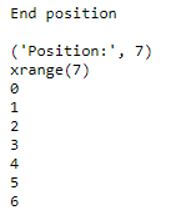Updated March 29, 2023

Introduction to Python 3 xrange
Python 3 xrange and range methods can be used to iterate a given number of times in for loops. There is no xrange in Python 3, although the range method operates similarly to xrange in Python 2. We should use range if we wish to develop code that runs on both Python 2 and Python 3. This function returns a generator object that can only be looped to display numbers.
What is Python 3 xrange?
- The only specific range is displayed only when it is requested, leading to the term “lazy evaluation.”
- If we are transitioning between Python 3 and Python 2, we could imagine that xrange objects in Python 2 and range objects in Python 3 are nearly identical. Isn’t it likely that they merely renamed xrange to range.
- The xrange function is a little more constrained than the range function in Python 3.
- When we ask for documentation for xrange using the help function, we get a list of dunder methods. When we employ several shared properties between different objects, Python uses Dunder methods like the len and str functions.
- Xrange is a built-in function that generates integers or whole numbers within a specified range. If we are using both 3 and 2.x the range and xrange comparison be useful. It’s because 3.x’s range method is simply a reimplementation of 2.x’s xrange. It works in a similar fashion to the xrange.
- Xrange returns a lazily evaluating sequence object. It is far more efficient, as it just computes the next value when it is required (through an xrange sequence object), rather than creating a list of all possible values as range does.
- Range is similar to xrange and it returns a list. We will have to do if we need to generate the list.
- Range replaces xrange, which is no longer available. We can’t use xrange to write Python 3 code.
- The xrange type has the advantage of always using the same amount of memory, regardless range size will represents.
- This function returns a generator object that can only be looped to display numbers. The xrange function works the same as the range function in generating a sequence of numbers. However, only Python 2.x uses xrange, while 3.x uses range.
How to Use Python 3 xrange?
1. While using the xrange function we need to specify the return type of function.
Code:
py = xrange(1,10000)
print ("Xrange return type: ")
print (type(py))Output:
2. When compared to the variable storing the range created by xrange. Range returns a list, whereas xrange returns an xrange object.
Code:
import sys
py = xrange(1,10000)
print ("Allocates size by using xrange:")
print (sys.getsizeof (py))Output:
3. Range produces a list, it can be used with any operation that can be applied to a list. However, because xrange returns an xrange object, actions related to lists cannot be performed on it.
Code:
py = xrange(1,6)
print ("List using xrange: ")
print (py[2:5])Output:
4. Xrange is faster to implement than range since it only evaluates the generator object holding the values required by lazy evaluation. The xrange function is deprecated in 3, we should use the range if we wish to develop code that will run on both 2 and 3. If we are iterating over the same sequence several times, the range is faster. Xrange must reconstruct the integer object each time it is called, whereas range will return genuine integer objects.
Functions
The syntax of the xrange function consists of 3 parameters:
Syntax:
xrange(start, end, step)- Start: This parameter indicates the sequence of numbers that should begin.
- End: This parameter indicates the sequence of numbers will come to an end.
- Step: This is the step parameter that was used in the function.
The end position must be defined. In the following example, we have defined the end parameter.
Code:
print ("End position\n")
py_end = 7
print ("Position:", py_end)
py = xrange(py_end)
print(py)
for py1 in py:
print (py1)Output:
In the below example we are defining the start, end, and step parameters with the function are as follows:
Code:
print("Start, End and Step parameter")
py1 = 2
py2 = 5
py3 = 2
print ("start pos:", py1)
print ("end pos:", py2)
print ("step:", py3)
py = xrange (5,13,2)
print (py)
for py4 in py:
print (py4)Output:
NameError
Xrange error message appears to imply that we are attempting to use 3 to execute a Python 2 codebase. In Python 2, the xrange method is frequently used to generate an iterable object, which behaves like a generator. The range function in Python 3 is similar to the method of xrange, hence there is no separate xrange method. As a result, using xrange in Python 3 will result in a NameError: name.
Below is the example of NameError as follows.
In the below example we are using “self” which was not defined so it will show this NameError message as the name “self is not defined.”
Code:
for py in xrange (self.epoch):
py1 = py*b_size
py2 = min((py+1)*b_size, d_size)
self.rank.append (np.asarray (self.t_rank [py1:py2]))Output:
Conclusion
Python 3 xrange and range methods can be used to iterate a given number of times in for loops. Range in Python 3 replaces xrange, which is no longer available. We can’t use xrange to write 3 code. Xrange returns a lazily evaluating sequence object.
Recommended Articles
This is a guide to Python 3 xrange. Here we discuss the introduction, how to use, function,s and name error respectively. You may also have a look at the following articles to learn more –






